

Macroevolution. Macroevolution is evolution on a scale of separated gene pools . [ 1 ] Macroevolutionary studies focus on change that occurs at or above the level of species , in contrast with microevolution , [ 2 ] which refers to smaller evolutionary changes (typically described as changes in allele frequencies ) within a species or population. [ 3 ] Contrary to claims by creationists , macro and microevolution describe fundamentally identical processes on different time scales. [ 4 ] [ 1 ]
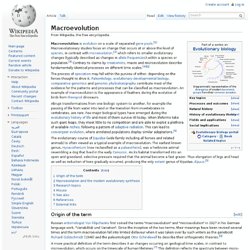
Microevolution. Microevolution is the changes in allele frequencies that occur over time within a population. [ 1 ] This change is due to four different processes: mutation , selection ( natural and artificial ), gene flow , and genetic drift . Population genetics is the branch of biology that provides the mathematical structure for the study of the process of microevolution. Ecological genetics concerns itself with observing microevolution in the wild. Typically, observable instances of evolution are examples of microevolution; for example, bacterial strains that have antibiotic resistance . Microevolution over time may lead to speciation or the appearance of novel structure, sometimes classified as macroevolution . [ 2 ] Contrary to claims by creationists however, macro and microevolution describe fundamentally identical processes on different time scales. [ 2 ] [ 3 ] [ edit ] Contrast with Macroevolution.
Speciation. Speciation is the evolutionary process by which new biological species arise.
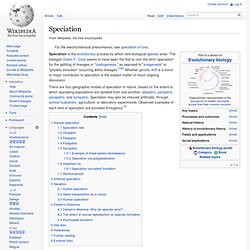
The biologist Orator F. Cook seems to have been the first to coin the term 'speciation' for the splitting of lineages or "cladogenesis," as opposed to "anagenesis" or "phyletic evolution" occurring within lineages.[1][2] Whether genetic drift is a minor or major contributor to speciation is the subject matter of much ongoing discussion. There are four geographic modes of speciation in nature, based on the extent to which speciating populations are isolated from one another: allopatric, peripatric, parapatric, and sympatric. Speciation may also be induced artificially, through animal husbandry, agriculture, or laboratory experiments. Gene flow. Gene flow is the transfer of alleles from one population to another population through immigration of individuals.
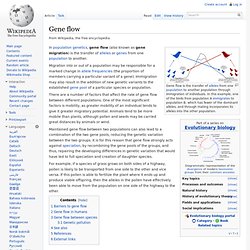
In this example, one of the birds from population A immigrates to population B, which has fewer of the dominant alleles, and through mating incorporates its alleles into the other population. In population genetics, gene flow (also known as gene migration) is the transfer of alleles or genes from one population to another. Genetic drift. Genetic drift or allelic drift is the change in the frequency of a gene variant (allele) in a population due to random sampling.[1] The alleles in the offspring are a sample of those in the parents, and chance has a role in determining whether a given individual survives and reproduces.

A population's allele frequency is the fraction of the copies of one gene that share a particular form.[2] Genetic drift may cause gene variants to disappear completely and thereby reduce genetic variation. Mutation. In genetics, a mutation is a change of the nucleotide sequence of the genome of an organism, virus, or extrachromosomal genetic element.
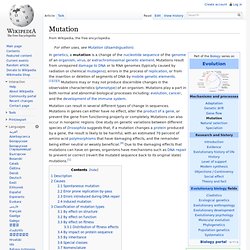
Mutations result from unrepaired damage to DNA or to RNA genomes (typically caused by radiation or chemical mutagens), errors in the process of replication, or from the insertion or deletion of segments of DNA by mobile genetic elements.[1][2][3] Mutations may or may not produce discernible changes in the observable characteristics (phenotype) of an organism. Mutations play a part in both normal and abnormal biological processes including: evolution, cancer, and the development of the immune system. Arsenic-based Life Finding Fails Follow-up. What Did They Really Find? (A 2011 Most Popular) Dec. 2, 2010: NASA-supported researchers announced that they had discovered the first known microorganism on Earth able to thrive and reproduce using the toxic chemical arsenic.
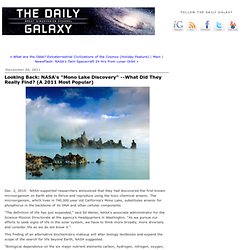
The microorganism, which lives in 740,000 year old California's Mono Lake, substitutes arsenic for phosphorus in the backbone of its DNA and other cellular components. "The definition of life has just expanded," said Ed Weiler, NASA's associate administrator for the Science Mission Directorate at the agency's Headquarters in Washington. "As we pursue our efforts to seek signs of life in the solar system, we have to think more broadly, more diversely and consider life as we do not know it.
" Natural selection. Variation exists within all populations of organisms.
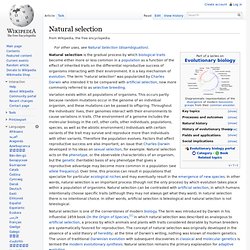
This occurs partly because random mutations occur in the genome of an individual organism, and these mutations can be passed to offspring. Throughout the individuals’ lives, their genomes interact with their environments to cause variations in traits.
What is Abiogenesis - Wikipedia. Scientific hypotheses about the origins of life can be divided into a number of categories.
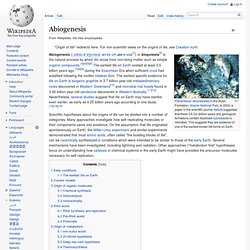
Many approaches investigate how self-replicating molecules or their components came into existence. On the assumption that life originated spontaneously on Earth, the Miller–Urey experiment and similar experiments demonstrated that most amino acids, often called "the building blocks of life", can be racemically synthesized in conditions which were intended to be similar to those of the early Earth. Several mechanisms have been investigated, including lightning and radiation. Other approaches ("metabolism first" hypotheses) focus on understanding how catalysis in chemical systems in the early Earth might have provided the precursor molecules necessary for self-replication. Early conditions[edit] Avalanche of Reactions at the Origin of Life. Mechanism of evolution of the primordial metabolism discovered Volcanic-hydrothermal flow channels offer a chemically unique environment, which at first glance appears hostile to life.
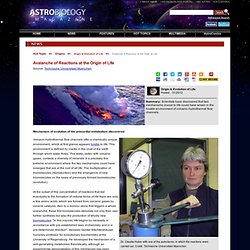
This environment is defined by cracks in the crust of the earth through which water flows. This water, laden with volcanic gases, contacts a diversity of minerals. British scientists recreate the molecules that gave birth to life itself. By Nick Enoch Updated: 08:03 GMT, 27 January 2012 Organic chemists at the University of York have recreated a pair of simple sugars - threose and erythrose - in a process which could have occurred before the advent of life Scientists are one step closer to understanding the origin of life after making a breakthrough into how sugar molecules found in DNA are created.
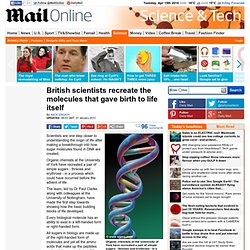
Organic chemists at the University of York have recreated a pair of simple sugars - threose and erythrose - in a process which could have occurred before the advent of life. The team, led by Dr Paul Clarke, along with colleagues at the University of Nottingham, have made the first step towards showing how the basic building blocks of life developed. Every biological molecule has an ability to exist in a left-handed form or right-handed form. Before DNA, before RNA: Life in the hodge-podge world - life - 08 January 2012. Take note, DNA and RNA: it's not all about you. Life on Earth may have begun with a splash of TNA – a different kind of genetic material altogether.
Because RNA can do many things at once, those studying the origins of life have long thought that it was the first genetic material. But the discovery that a chemical relative called TNA can perform one of RNA's defining functions calls this into question. Instead, the very first forms of life may have used a mix of genetic materials. Today, most life bar some viruses uses DNA to store information, and RNA to execute the instructions encoded by that DNA. A key piece of evidence for this "RNA world" hypothesis is that RNA is a jack of all trades.
Now it seems TNA might have been just as capable, although it is not found in nature today. It differs from RNA and DNA in its sugar backbone: TNA uses threose where RNA uses ribose and DNA deoxyribose. Evolution of cells. The first cells[edit] The origin of cells was the most important step in the evolution of life on Earth. The birth of the cell marked the passage from pre-biotic chemistry to partitioned units resembling modern cells.
The final transition to living entities that fulfill all the definitions of modern cells depended on the ability to evolve effectively by natural selection. This transition has been called the Darwinian transition. Twist in the tail of eukaryotic origins - life - 19 December 2011. Complex life may have had parasitic origins. New evidence suggests that the relatives of the mitochondria within our cells once had a tail, like many parasitic bacteria. Life on Earth is packaged into three domains: the simple bacteria, the archaea, and the complex eukaryotes that make up most of the life we see with the naked eye. The first eukaryotes appeared around 2 billion years ago. One popular theory suggests they did so after an immobile bacterium was ingested by an archaeon.
The bacterium somehow escaped being digested and instead formed a symbiotic relationship with its consumer. Different picture Nathan Lo at the University of Sydney in Australia and Claudio Bandi at the University of Milan, Italy, and colleagues think it is time to view this serendipitous encounter in a different light. That suggests that the bacteria might once have been mobile, like many parasitic bacteria. Adaptation. General principles[edit] The significance of an adaptation can only be understood in relation to the total biology of the species.— Julian Huxley[1] Adaptation is one of the two main processes that explain the diverse species we see in biology, such as the different species of Darwin's finches.
The other is speciation (species-splitting or cladogenesis), caused by geographical isolation or some other mechanism.[8][9] A favorite example used today to study the interplay of adaptation and speciation is the evolution of cichlid fish in African lakes, where the question of reproductive isolation is much more complex.[10][11] Adaptation is not always a simple matter, where the ideal phenotype evolves for a given external environment. An organism must be viable at all stages of its development and at all stages of its evolution. Definitions[edit] The following definitions are mainly due to Theodosius Dobzhansky. 1. 2.